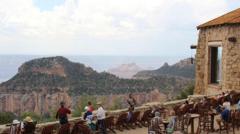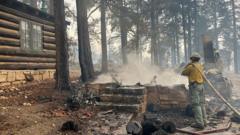Emergency responders are engaged in a frantic race against time to shield both people and cultural treasures from wildfires ravaging South Korea's southeast region.
Rescue Efforts Intensify Amid South Korea's Historic Wildfires

Rescue Efforts Intensify Amid South Korea's Historic Wildfires
As South Korea battles its largest wildfires ever, the nation faces devastating losses including human lives and irreplaceable heritage sites.
South Korea is grappling with its most extensive wildfires on record, which have wreaked havoc for over a week, prompting a major evacuation and the tragic loss of lives and historical heritage.
Authorities confirmed that at least 27 individuals have succumbed to the flames as the wildfires transformed into an uncontrollable force across 88,000 acres of land. The government reported that approximately 37,000 residents were evacuated from their homes due to the relentless blaze, which intensified amidst ongoing dry and windy conditions. The most significant fire incident occurred in Euiseong County, which was still only partially under control as of Thursday.
Rescue teams are not only focusing on public safety but also on the urgent preservation of South Korea's historic assets. In an unfortunate turn of events, two ancient Buddhist temples, both dating back 1,000 years, have been completely destroyed. The Korea Heritage Service reported that as many as two dozen culturally significant sites, including buildings, statues, and even ancient trees have succumbed to the inferno.
Images from Gounsa Temple reveal a silver lining as the main temple structure survived despite the surrounding buildings suffering severe damage during the fire. Among the losses, a revered 9th-century Buddha statue has been reduced to ashes, along with the remains of a 400-year-old tree that symbolized protection for the adjacent village.
In response to the crisis, approximately 750 personnel have been deployed across the affected southeastern region to safeguard remaining cultural assets. This area is home to more than 4,000 items recognized on South Korea's national heritage list, underscoring the catastrophic impact of these wildfires not just on property and lives, but on the cultural fabric of the nation as well.
Authorities confirmed that at least 27 individuals have succumbed to the flames as the wildfires transformed into an uncontrollable force across 88,000 acres of land. The government reported that approximately 37,000 residents were evacuated from their homes due to the relentless blaze, which intensified amidst ongoing dry and windy conditions. The most significant fire incident occurred in Euiseong County, which was still only partially under control as of Thursday.
Rescue teams are not only focusing on public safety but also on the urgent preservation of South Korea's historic assets. In an unfortunate turn of events, two ancient Buddhist temples, both dating back 1,000 years, have been completely destroyed. The Korea Heritage Service reported that as many as two dozen culturally significant sites, including buildings, statues, and even ancient trees have succumbed to the inferno.
Images from Gounsa Temple reveal a silver lining as the main temple structure survived despite the surrounding buildings suffering severe damage during the fire. Among the losses, a revered 9th-century Buddha statue has been reduced to ashes, along with the remains of a 400-year-old tree that symbolized protection for the adjacent village.
In response to the crisis, approximately 750 personnel have been deployed across the affected southeastern region to safeguard remaining cultural assets. This area is home to more than 4,000 items recognized on South Korea's national heritage list, underscoring the catastrophic impact of these wildfires not just on property and lives, but on the cultural fabric of the nation as well.



















